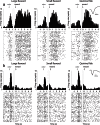Separate populations of neurons in ventral striatum encode value and motivation
- PMID: 23724077
- PMCID: PMC3665540
- DOI: 10.1371/journal.pone.0064673
Separate populations of neurons in ventral striatum encode value and motivation
Abstract
Neurons in the ventral striatum (VS) fire to cues that predict differently valued rewards. It is unclear whether this activity represents the value associated with the expected reward or the level of motivation induced by reward anticipation. To distinguish between the two, we trained rats on a task in which we varied value independently from motivation by manipulating the size of the reward expected on correct trials and the threat of punishment expected upon errors. We found that separate populations of neurons in VS encode expected value and motivation.
Conflict of interest statement
Figures






References
-
- Mogenson GJ, Jones DL, Yim CY (1980) From motivation to action: functional interface between the limbic system and the motor system. Prog Neurobiol 14: 69–97. - PubMed
-
- Barto A, editor (1995) Adaptive critics and the basal ganglia.
-
- Niv Y, Schoenbaum G (2008) Dialogues on prediction errors. Trends Cogn Sci 12: 265–272. - PubMed
-
- Sutton RaB, AG editor (1998) Reinforcement Learning: An introduction.
Publication types
MeSH terms
Grants and funding
LinkOut - more resources
Full Text Sources
Other Literature Sources

